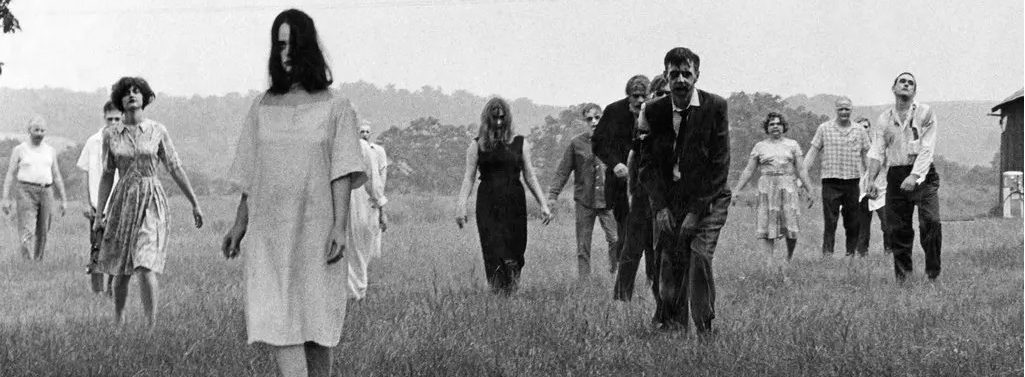The opening and the last part of Richard Dyer’s “White,” which you read for today, suggests that Night of the Living Dead draws attention not just to Ben’s blackness but to the whiteness of all the characters around him. The movie does this, in Dyer’s thinking, even if the characters themselves never mention race. Pick a scene (other than the shooting at the end) where you see the movie putting forth an idea of whiteness and blackness that’s particularly striking.
5 thoughts on “Night of the Living Dead 2”
Leave a Reply
You must be logged in to post a comment.

There is one scene in particular that I wouldn’t say draws attention to Ben’s blackness but definitely is something that wouldn’t have been shown during the time. There is a point where Ben wants the people to stay in one room of the house with the radio so they can be aware of what’s going on while Harry insists that they should all go to the basement. Ben takes control of the situation and I think him being the only black character is what makes the scene about race “Now get the hell down in the cellar, you can be the boss down there, I’m the boss up here”. Even though this isn’t implicitly about race, I think it becomes more about Ben, a black man, being a leading figure.
imilar to Branden, the scene that struck me the most in terms of unspoken racial dynamics was when Ben and Mr. Cooper arguing about staying upstairs versus hiding in the basement. Although it is not explicitly addressed, Cooper’s refusal to follow Ben’s lead feels like more than just a personality clash. It hangs at a much deeper and unspoken tension about power and control. Traditionally white male actors were being placed in these sort of ‘heroic’ roles, so Ben being a leader clearly bothers Cooper, who embodies a sort of defensive white privilege. His resistance to Ben’s authority clearly reflects discomfort (and even hostility) with a Black man being in charge, which reinforces Dyer’s idea that the film make whiteness visible by how it contrasts with blackness.
I also spoke about the same thing. Though it is not directly about race, what makes it so is the fact that this is one of the first times that a black actor is put into this kind of leading role. What I hadn’t thought about is that the conflict between him and Harry could be used as a sort of metaphor for a sort of black vs. white. Though this may have not been the director’s intention, it most certainly was made culturally relevant regardless.
One particularly striking scene that highlights the contrast between whiteness and blackness, in line with Richard Dyer’s ideas from White, is the confrontation between Ben and Mr. Cooper over control of the house. This moment becomes a symbolic clash, not only in terms of leadership and survival strategies but also in how whiteness and blackness are represented. In this scene, Mr. Cooper insists on taking refuge in the basement, asserting his authority as a white, middle-class man and the presumed head of the family. His insistence on retreating to the basement, despite Ben’s more pragmatic approach to boarding up the windows and staying upstairs, underscores his desire to maintain control and uphold traditional power dynamics. Cooper’s obstinance, though never overtly tied to race in the dialogue, resonates with a kind of defensive white privilege—a reluctance to relinquish control or adapt to a situation where a Black man is in charge. Ben, by contrast, is calm, rational, and resourceful, qualities often reserved for white characters in films of this era. His blackness, in Dyer’s terms, is made more visible because of the surrounding whiteness that refuses to acknowledge his competence. While no one in the scene overtly discusses race, the visual and behavioral contrasts between Ben and Cooper make the racial dynamics impossible to ignore. Cooper’s resistance to Ben’s authority, even when it’s clear that Ben has the better survival plan, becomes a metaphor for white resistance to Black leadership and competence. The tension between these two characters, both in terms of their actions and the unspoken racial dynamics, subtly reinforces Dyer’s argument that Night of the Living Dead doesn’t just draw attention to Ben’s blackness but also to the whiteness of the people around him—people who refuse to recognize Ben’s superiority in the situation due to entrenched racial attitudes.
The scene where Tom and Harry come upstairs is a very interesting one in terms of how it posits whiteness and blackness. Harry is very sure that he is right about everything, especially the cellar being the safest place to be, and is unwilling to hear what Ben has to say, even after he has boarded up the whole house. He almost seems to come around when Tom, another white man, tries to reiterate what Ben is saying, but that is discarded after the Dead get through the window briefly. This uncompromising attitude that whatever he says is right seems to position Harry as thinking that he has power over Ben and knows better than him. They don’t exactly come to an agreement through the whole film and we constantly see Harry being unwilling to go along with Ben’s ideas or blaming Ben. It was also very interesting when instead of an agreement they come to a compromise that Ben will be in charge upstairs and Harry can be in charge downstairs in the cellar. It seems to almost be a reversal of traditional racial roles, as it puts Ben above the white man who is trying to tear him down.